Medical Disclaimer: The information in this blog is for enlightening and educational purposes only and is not intended as medical advice. The content in this post about how to relieve elbow pain from lifting is not meant to substitute for a professional medical diagnosis, advice, or treatment. Always ask advice from your physician or other qualified health providers with any questions you may have regarding a medical condition.
Elbow pain is something many people experience when lifting weights, whether you’re just starting or have been lifting for a while. If you’re wondering how to relieve elbow pain from lifting, it’s important to understand that lifting heavy weights over and over can put strain on your elbows, leading to pain or even serious injury if not treated.
It’s important to catch and treat elbow pain early to avoid long-term problems. In this blog, we’ll share simple tips and solutions to help relieve elbow pain from lifting, so you can get back to your workouts feeling better and stronger.
1. Push Up Movement
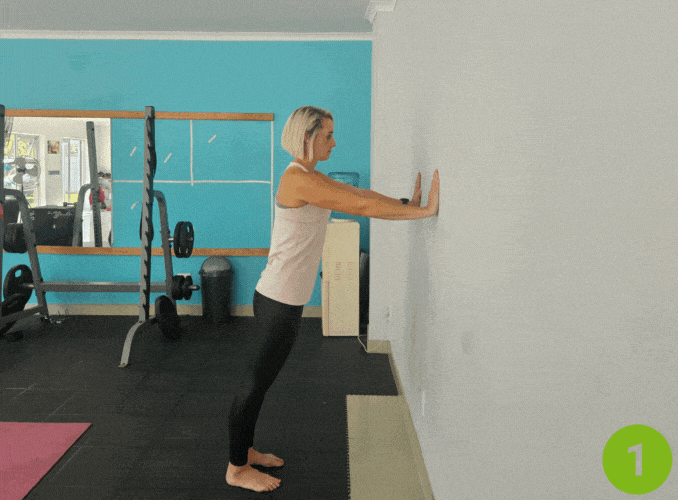
- Begin in an upright standing position in front of the wall with your feet hip-width apart, maintaining good alignment with your head, shoulders, hips, and legs.
- Place both hands against the wall at shoulder height and step back with both feet to increase the angle of your body.
- Engage your core and bend your elbows to lower your upper body towards the wall, keeping your elbows tight to the side.
- Straighten your arms to return to the starting position and repeat the movement.
- Complete 3 sets, 10 repetitions.
2. Arm Circles
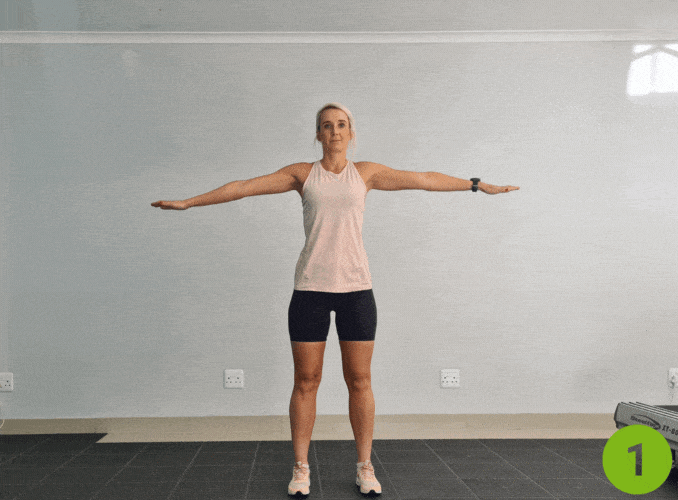
- Begin in an upright standing position with your feet hip-width apart, maintaining good alignment with your head, shoulders, hips, and legs.
- Extend your arms out at your sides at shoulder height and open your chest.
- Engage your core and move your arms in a large circular motion.
- Repeat the movement.
3. Arms Overhead
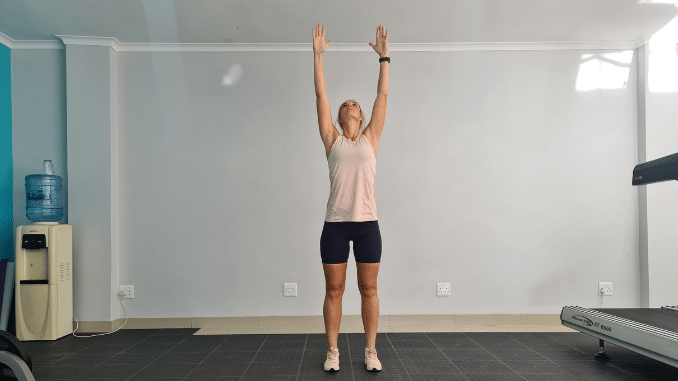
- Begin in an upright standing position with your feet shoulder-width apart, maintaining good alignment with your head, shoulders, hips, and legs.
- Raise both arms upwards and stretch them, but only to a level where you can do so without hurting or risking injury.
- Then, take a deep breath and lower them back down returning to the starting position and repeat the movement.
- Complete the movement for 5 – 10 repetitions.
4. Arm Curl
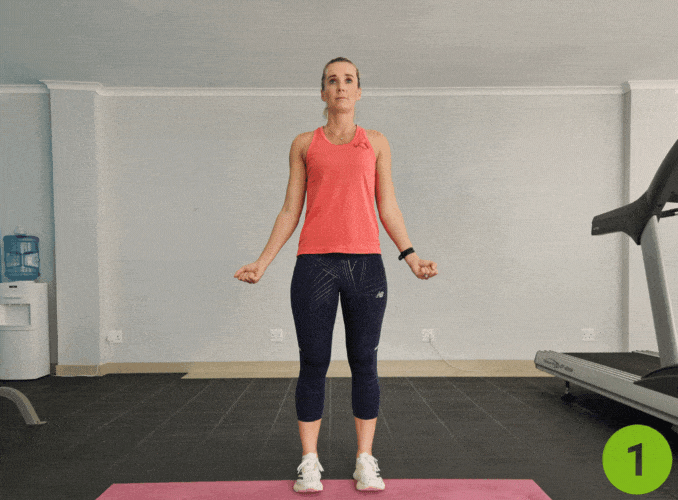
- Begin in an upright standing position with your feet shoulder-width apart, maintaining good alignment with your head, shoulders, hips, and legs.
- Place both arms to your sides, with both fists closed.
- Engage your core muscles.
- Bend your arms inward until your hands reach your shoulders.
- Lower your arms back to the starting position and repeat the movement 10 times.
5. Wrist Circles

- Begin in an upright standing position with your feet shoulder-width apart, maintaining good alignment with your head, shoulders, hips, and legs.
- Extend your arms in front at chest level with palms facing up.
- Engage your core muscles and move your wrist in a circular motion.
- Repeat the movement with 10 repetitions.
6. Tricep Extension Stretch
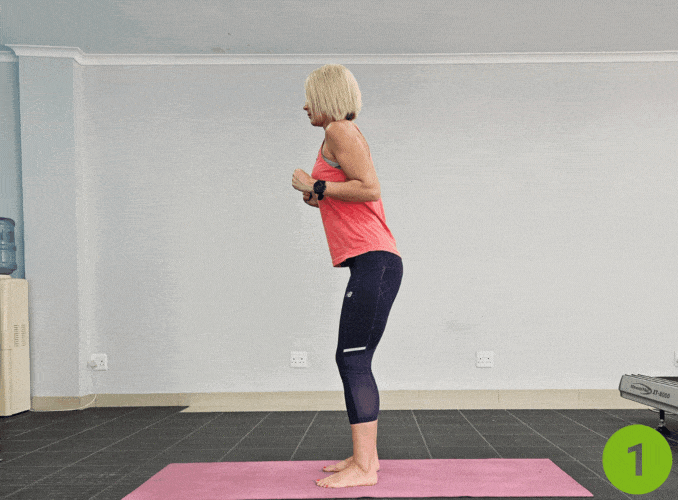
- Begin in an upright standing position with your feet hip-width apart, maintaining good alignment with your head, shoulders, hips, and legs.
- Bend your elbows with your hands closed at chest level.
- Slightly bend your knees and move your upper body forward.
- Engage your core muscles.
- Straighten your arms, extending it back slightly past your hips.
- Hold the position for a couple of seconds.
- Bend your elbows back to the starting position and repeat the movement with 10 repetitions.
7. Wrist Extension Stretch
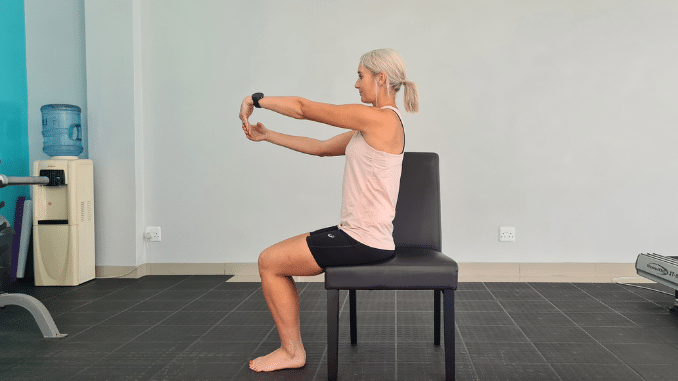
- Begin in an upright sitting position on a chair with your knees bent and feet flat on the floor.
- Maintain good alignment with your head, shoulders, and hips.
- Engage your core muscles.
- Extend your affected arm with your fingers pointing towards the floor, then using your opposite hand, gently bend the fingers towards you.
- Hold the position for a few seconds. Relax and repeat the movement on the opposite side.
8. Wrist Flexion Stretch

- Begin in an upright sitting position on a chair with your knees bent and feet flat on the floor.
- Maintain good alignment with your head, shoulders, and hips.
- Engage your core muscles.
- Extend your affected arm with your fingers pointing towards the ceiling, then using your opposite hand, gently bend the fingers towards you.
- Hold the position for a few seconds. Relax and repeat the movement on the opposite side.
9. Scapular Wall Slides

- Begin in an upright standing position with your back against a wall, maintaining good alignment with your head, shoulders, hips, and legs. Press your lower back, upper back, and head into the wall.
- Engage your core. Raise your arms into a “W” position with your elbows bent at 90 degrees.
- Slowly slide your arms up into a “Y” position while keeping contact with the wall.
- Keep your core engaged, and avoid arching your lower back.
- This exercise helps improve shoulder mobility and posture by activating and stabilizing the muscles around the shoulder blades.
- Repeat the movement with 3 sets of 10 repetitions.
According to Dr. Jeffrey Peng, a nonoperative orthopedist and sports medicine specialist, performing targeted stretches and exercises three times a day can significantly improve mobility and reduce discomfort associated with conditions like tennis elbow and golfer’s elbow.
Understanding Elbow Pain
Symptoms
- Persistent pain on the inner elbow worsens with gripping or lifting.
- Tenderness around the bony bump on the inner elbow.
- Elbow stiffness, especially in the morning or after rest.
- Weakness in hands and wrists, making lifting difficult.
Causes
- Repetitive motions like gripping, twisting, or lifting improperly.
- Incorrect technique during weightlifting or other activities.
- Sudden force or impact to the elbow.
Types Of Elbow Pain
1. Lateral Elbow Pain
This is commonly referred to as “tennis elbow” and is typically caused by overuse of the forearm muscles and tendons, leading to inflammation on the outer side of the elbow. It is often seen in people who engage in repetitive activities like tennis or other sports involving gripping and twisting motions. Lateral elbow pain can also be triggered by simple daily tasks, such as gripping a tool or lifting objects.
2. Elbow Bursitis
This condition occurs when the small fluid-filled sac (bursa) at the back of the elbow becomes inflamed, often due to injury, overuse, or prolonged pressure. The inflammation causes swelling and pain at the elbow, especially when bending the arm. Bursitis can result from activities like leaning on the elbows for long periods or repetitive elbow movements.
3. Triceps Tendonitis
Triceps tendonitis is the inflammation that connects the triceps muscle to the elbow. It typically occurs due to overuse or repetitive activities that involve heavy lifting or pushing motions. The pain is often felt at the back of the elbow and can worsen with movements such as lifting or extending the arm.
4. Medial Elbow Pain
This type of pain is less common than outer elbow pain [1] and is typically caused by repetitive movements such as throwing or lifting heavy objects. It refers to general pain felt on the inner side of the elbow.
5. Medial Epicondylitis (ME)
Medial epicondylitis [²], often called golfer’s elbow, happens when the tendons on the inner side of your elbow become damaged from repetitive stress. This damage can lead to tendon breakdown and sometimes hardening or calcification. People with golfer’s elbow feel ongoing pain on the inside of their elbows, especially when doing daily tasks. Athletes might notice more pain during certain stages of throwing.
6. Medial Collateral Ligament (MCL)
Medial Collateral Ligament (MCL) injury [³], also called the Ulnar Collateral Ligament (UCL) injury, is commonly associated with athletes, particularly baseball pitchers, due to the repetitive stress and strain placed on the elbow joint during throwing motions.
Other Treatment Of Lifter’s Elbow
Treatment for how to relieve elbow pain from lifting usually involves a combination of rest, ice or heat therapy, medications, and physical therapy exercises:
- Rest: Avoid activities that aggravate the pain and give the elbow time to heal.
- Ice or Heat Therapy: Applying ice packs or warm compresses can help reduce inflammation and relieve pain.
- Medications: Over-the-counter pain relievers like ibuprofen or naproxen can help manage pain and reduce inflammation.
- Physical Therapy: Stretching and strengthening exercises prescribed by a physical therapist can improve flexibility and strength in the forearm muscles.
It was also supported by Cleveland Clinic experts and Harvard Health advocating the use of the P.R.I.C.E. method (Protect, Rest, Ice, Compression, Elevation) for managing elbow pain at home.
Prevention Of Lifter’s Elbow
Preventing Lifter’s Elbow involves taking steps to reduce stress on the tendons and muscles of the forearm:
- Proper Technique: Use proper technique and form when lifting weights or performing repetitive motions.
- Warm-Up: Always warm up before exercising or engaging in activities that involve repetitive arm movements.
- Gradual Progression: Gradually increase the intensity and duration of activities to allow muscles and tendons to adapt.
- Rest and Recovery: Take regular breaks during activities to rest your arms and allow them to recover.
- Equipment Adjustment: Ensure proper grip size on equipment, adjust weightlifting machines to align with your height, and avoid overly tight or loose grips that strain the forearm muscles.
These measures not only treat but also prevent elbow pain and overuse injuries like tennis elbow, ensuring better inner elbow health and reducing the risk of chronic pain.
Conclusion
Managing elbow pain from lifting requires proactive care and understanding of its causes. By incorporating effective exercises, rest, therapy, and preventive measures on how to relieve elbow pain from lifting, you can alleviate discomfort and prevent future injuries.
Remember, early intervention is key to maintaining strength and enjoying your workouts pain-free. By maintaining proper technique and allowing adequate rest, you can ensure long-term elbow health and continue your fitness journey pain-free.
Check out Tennis Elbow Pain Solution for your guide to eliminating elbow pain!
FAQ’s
How Do You Fix a Sore Elbow From Lifting?
To fix a sore elbow from lifting, rest the elbow, apply ice or heat, use over-the-counter pain relievers, and gradually start gentle stretching and strengthening exercises recommended by a physical therapist.
How Long Does the Lifter’s Elbow Take to Heal?
Recovery time for a lifter’s elbow varies but usually ranges from weeks to months depending on the severity and treatment.
What Is The Fastest Way to Relieve Elbow Pain?
The fastest way to relieve elbow pain includes resting the elbow, applying ice or heat packs, taking over-the-counter pain medications, and following prescribed stretching and strengthening exercises.
Will Elbow Pain Go Away?
With proper treatment and care, elbow pain often improves over time. Consistent use of preventive measures can help manage and reduce the risk of chronic pain.


